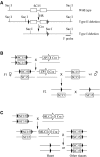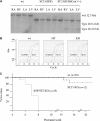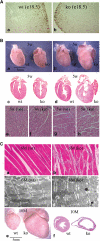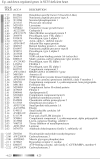Dilated cardiomyopathy caused by tissue-specific ablation of SC35 in the heart
- PMID: 14963485
- PMCID: PMC380988
- DOI: 10.1038/sj.emboj.7600054
Dilated cardiomyopathy caused by tissue-specific ablation of SC35 in the heart
Abstract
Many genetic diseases are caused by mutations in cis-acting splicing signals, but few are triggered by defective trans-acting splicing factors. Here we report that tissue-specific ablation of the splicing factor SC35 in the heart causes dilated cardiomyopathy (DCM). Although SC35 was deleted early in cardiogenesis by using the MLC-2v-Cre transgenic mouse, heart development appeared largely unaffected, with the DCM phenotype developing 3-5 weeks after birth and the mutant animals having a normal life span. This nonlethal phenotype allowed the identification of downregulated genes by microarray, one of which was the cardiac-specific ryanodine receptor 2. We showed that downregulation of this critical Ca2+ release channel preceded disease symptoms and that the mutant cardiomyocytes exhibited frequency-dependent excitation-contraction coupling defects. The implication of SC35 in heart disease agrees with a recently documented link of SC35 expression to heart failure and interference of splicing regulation during infection by myocarditis-causing viruses. These studies raise a new paradigm for the etiology of certain human heart diseases of genetic or environmental origin that may be triggered by dysfunction in RNA processing.
Figures






Similar articles
-
Cardiomyocyte-Specific Ablation of Med1 Subunit of the Mediator Complex Causes Lethal Dilated Cardiomyopathy in Mice.PLoS One. 2016 Aug 22;11(8):e0160755. doi: 10.1371/journal.pone.0160755. eCollection 2016. PLoS One. 2016. PMID: 27548259 Free PMC article.
-
Gene expression profile in dilated cardiomyopathy caused by elevated frequencies of mitochondrial DNA mutations in the mouse heart.Cardiovasc Pathol. 2005 Mar-Apr;14(2):61-9. doi: 10.1016/j.carpath.2005.01.006. Cardiovasc Pathol. 2005. PMID: 15780797
-
Dilated cardiomyopathy mutant tropomyosin mice develop cardiac dysfunction with significantly decreased fractional shortening and myofilament calcium sensitivity.Circ Res. 2007 Jul 20;101(2):205-14. doi: 10.1161/CIRCRESAHA.107.148379. Epub 2007 Jun 7. Circ Res. 2007. PMID: 17556658
-
Inflammatory dilated cardiomyopathy (DCMI).Herz. 2005 Sep;30(6):535-44. doi: 10.1007/s00059-005-2730-5. Herz. 2005. PMID: 16170686 Review.
-
Mechanisms of RBM20 Cardiomyopathy: Insights From Model Systems.Circ Genom Precis Med. 2024 Feb;17(1):e004355. doi: 10.1161/CIRCGEN.123.004355. Epub 2024 Jan 30. Circ Genom Precis Med. 2024. PMID: 38288598 Free PMC article. Review.
Cited by
-
The SR family proteins B52 and dASF/SF2 modulate development of the Drosophila visual system by regulating specific RNA targets.Mol Cell Biol. 2007 Apr;27(8):3087-97. doi: 10.1128/MCB.01876-06. Epub 2007 Feb 5. Mol Cell Biol. 2007. PMID: 17283056 Free PMC article.
-
Alternative splicing is frequent during early embryonic development in mouse.BMC Genomics. 2010 Jun 23;11:399. doi: 10.1186/1471-2164-11-399. BMC Genomics. 2010. PMID: 20573213 Free PMC article.
-
Global analysis reveals SRp20- and SRp75-specific mRNPs in cycling and neural cells.Nat Struct Mol Biol. 2010 Aug;17(8):962-70. doi: 10.1038/nsmb.1862. Epub 2010 Jul 18. Nat Struct Mol Biol. 2010. PMID: 20639886
-
Loss of SRSF3 in Cardiomyocytes Leads to Decapping of Contraction-Related mRNAs and Severe Systolic Dysfunction.Circ Res. 2019 Jul 5;125(2):170-183. doi: 10.1161/CIRCRESAHA.118.314515. Epub 2019 May 30. Circ Res. 2019. PMID: 31145021 Free PMC article.
-
Loss of SRSF2 triggers hepatic progenitor cell activation and tumor development in mice.Commun Biol. 2020 May 5;3(1):210. doi: 10.1038/s42003-020-0893-5. Commun Biol. 2020. PMID: 32372053 Free PMC article.
References
-
- Biesiadecki BJ, Elder BD, Yu ZB, Jin JP (2002) Cardiac troponin T variants produced by aberrant splicing of multiple exons in animals with high instances of dilated cardiomyopathy. J Biol Chem 277: 50275–50285 - PubMed
-
- Black DL (2000) Protein diversity from alternative splicing: a challenge for bioinformatics and post-genome biology. Cell 103: 367–370 - PubMed
-
- Bonne G, Carrier L, Richard P, Hainque B, Schwartz K (1998) Familial hypertrophic cardiomyopathy: from mutations to functional defects. Circ Res 83: 580–593 - PubMed
-
- Burge CB, Tuschl TH, Sharp PA (1999) Splicing of precursors to mRNA by the spliceosome. In The RNA World II, Gesteland RF, Cech TR, Atkins JF (eds), pp 525–560
Publication types
MeSH terms
Substances
Grants and funding
LinkOut - more resources
Full Text Sources
Molecular Biology Databases
Miscellaneous

